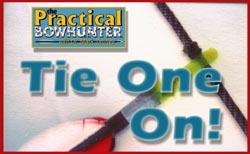

with Dr. Mark Timney
 |
 with Dr. Mark Timney |
How to `tie one on'
It costs just a few cents... takes only a second to put on... works like a charm 99.99% of the time... and can absolutely ruin a hunt when it fails. Despite its size, the nock on your string plays a big part in making your bow work.
For years now, the brass nock has been standard equipment. And why not? It works well. But a tied-on nock works even better. It's less likely to slip or damage your serving, is easier to adjust, and even allows your bow to shoot a few feet-per-second faster because of it weighs less than a brass nock.
If you tie a nock on properly it will last through at least a year of regular shooting. I've had these nocks on my hunting and 3-D bows for over two years and they're still working perfectly.
THE MATERIALS
You'll only need a few items for this project:
THE PROCEDURE
Wrap the piece of serving material around the bow string and begin as if you were tying your shoe. You're going to tie the first half of a square knot, stop, and pull the ends snugly by hand.
Take the two string ends around the back of the bow string and repeat the process on that side. Make sure to cross the strings in the same direction as you did on the front to keep the nock looking neat. If you went right-over-left on the front, do the same on the back. Pull the ends snug by hand again.
Bring the ends around the front again and repeat. Continue this process until you've completed a series of four `ties' on the front of the string and four on the back.
Bring both ends around the front and finish off the nock by tying a square knot (right-over-left with the first tie and left-over-right to finish). Use the plyers to pull the knot as tight as possible. Now, either cut or burn the excess string off as close to the knot as possible. Next, spread glue on the knot and nock to harden it and keep things tight. DO NOT allow the glue to soak through to the center serving or bow string. You want to be able to twist the knock up and down the serving to adjust nock height. (You might have to work at the nock a bit to get it to move at first.)
While this may seem like a low-tech solution, it isn't. In fact, a good number of professional archers tie on their nocks. They're sold on the reliability and adjustability. So am I. And you will be too.... once you try it.